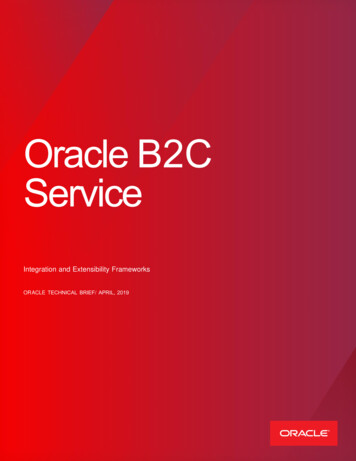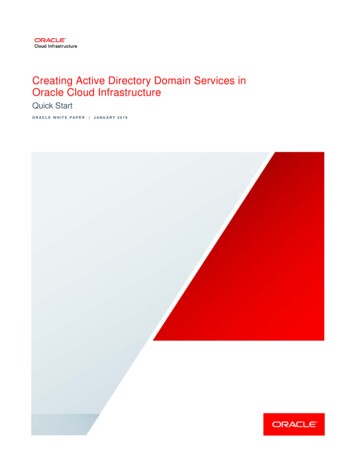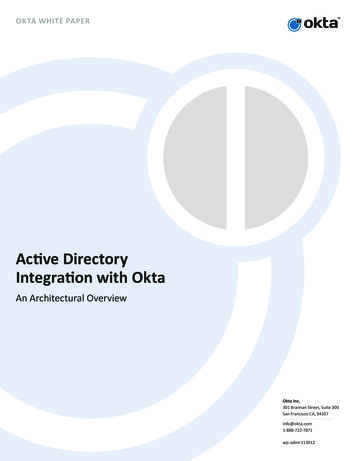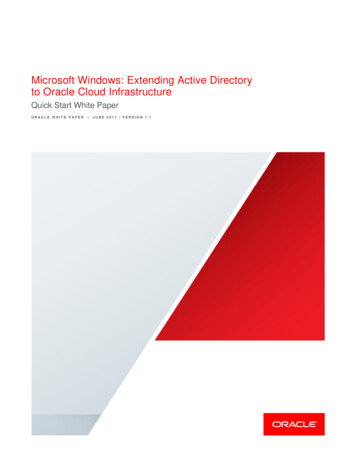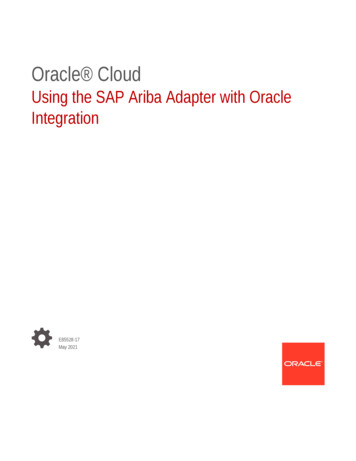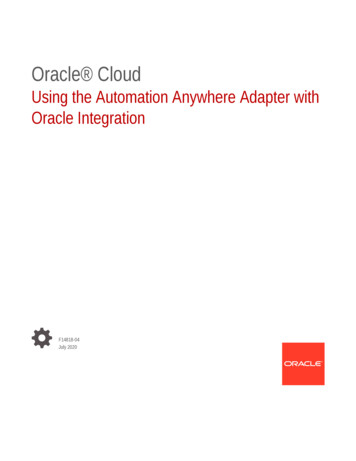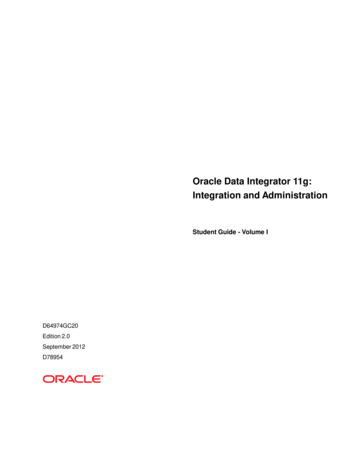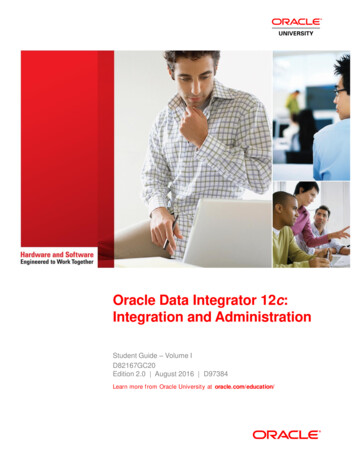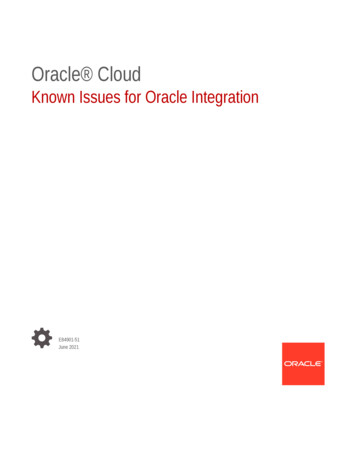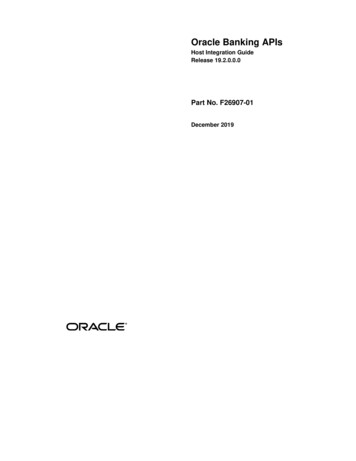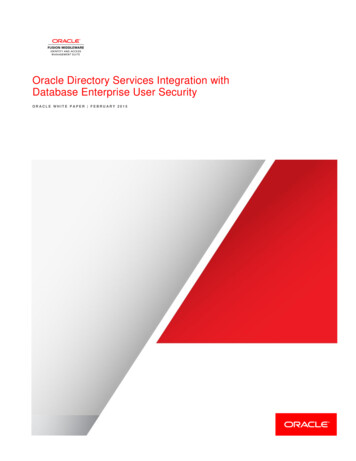
Transcription
Oracle Directory Services Integration withDatabase Enterprise User SecurityORACLE WHITE PAPER FEBRUARY 2015
DisclaimerThe following is intended to outline our general product direction. It is intended for informationpurposes only, and may not be incorporated into any contract. It is not a commitment to deliver anymaterial, code, or functionality, and should not be relied upon in making purchasing decisions. Thedevelopment, release, and timing of any features or functionality described for Oracle’s productsremains at the sole discretion of Oracle.ORACLE DIRECTORY SERVICES INTEGRATION WITH DB ENTERPRISE USER SECURITY
Table of ContentsIntroduction1Centralizing DB Accounts with OUD2 DB Accounts Stored in OUD2 DB Accounts Proxy-ed by OUD into existing Directories4Accounts in Microsoft Active Directory4Active Directory Integration for Password-based authentication4Active Directory Integration with Kerberos Authentication6Accounts in ODSEE7Accounts in Novell eDirectory8Centralizing DB Accounts with OID9 DB Accounts Stored in OID9 DB Accounts in existing directories referred to via OIDActive Directory Integration for Password Authentication1111AD as the source for password change11OID as the source for password change11Active Directory Integration for Kerberos Authentication12DSEE Integration13Conclusion13Appendix A: Supported Deployments with minimum version numbers14ORACLE DIRECTORY SERVICES INTEGRATION WITH DB ENTERPRISE USER SECURITY
IntroductionIT departments are under consistent pressure to reduce cost, enhance security, and improvecompliance to support ever-competitive business. Databases are critical components of enterprise ITinfrastructure, so it is key to centralize and integrate database users and privileges into an enterpriseidentity management framework.However, many enterprises today still manage users and privileges on an individual database basis.From an end-user perspective, this means that each user must remember multiple passwords. Froman administration perspective, redundant user management is costly; managing user authorizations inmultiple databases is error-prone. From an auditing and compliance perspective, on-time provisioningand de-provisioning of user access and privileges across databases is challenging.Enterprise User Security (EUS), an Oracle Database Enterprise Edition feature, leverages the OracleDirectory Services and gives you the ability to centrally manage database users and role membershipsin an LDAP directory. EUS reduces administration costs and increases security. EUS also improvescompliance by centralizing database user account management, provisioning and de-provisioning ofdatabase users, password management and self-service password reset, and management ofauthorizations using global database roles. Furthermore, password policies (including account lockoutand password expiration settings) defined in the LDAP-compliant directory and stored in user entriescan be used by EUS.This paper presents the EUS deployment options available with Oracle Unified Directory (OUD) andOracle Internet Directory (OID). Both use cases will be covered in this document. The two directoriescan be used as the central directory repository for database users and privileges as well as be used asa EUS directory virtualization service to leverage existing directory infrastructures based on MicrosoftActive Directory (AD), Novell eDirectory, or Oracle Directory Server Enterprise Edition (ODSEE) oreven OUD.1 ORACLE DIRECTORY SERVICES INTEGRATION WITH DB ENTERPRISE USER SECURITY
Centralizing DB Accounts with OUD DB Accounts Stored in OUDOUD works seamlessly with EUS. Database user information, passwords and privileges information for a databaseor for a database domain can be stored in OUD.EUS can leverage existing user and group information stored in OUD to provide single password authentication andconsistent password policy across enterprise applications. User data, database metadata, such as DB registrationinformation, user/role Mappings, and other EUS specific metadata are stored in OUD using a specific, supported,ready-to-use LDAP schema. These metadata are stored in a separate OUD suffix, called Oracle Context, making aclean logical separation between EUS data and user information that can be shared across applications.In addition to providing centralized database user management, Enterprise EUS provides three different methods ofuser authentication:1.X.509 certificate authentication (introduced in DB 8i)2.Password-based authentication (since DB 9i)3.Authentication via Kerberos (since DB 10g).OUD support for Password-based authentication for EUS was introduced in OUD 11gR2 (11.1.2.0.0). The otherauthentication methods were introduced in OUD 11gR2PS1 (11.1.2.1).In the password authentication scenario, the database does not perform user authentication via LDAP bind to OUD.Instead the database performs the authentication via reading user credentials, hashing the password, andcomparing the password hash value retrieved from OUD. More detailed information about EUS can be found in theEnterprise User Administrator's Guide in the Database documentation section on Oracle technology Network.2 ORACLE DIRECTORY SERVICES INTEGRATION WITH DB ENTERPRISE USER SECURITY
Figure 1: EUS Account management with OUD3 ORACLE DIRECTORY SERVICES INTEGRATION WITH DB ENTERPRISE USER SECURITY
DB Accounts Proxy-ed by OUD into existing DirectoriesAs most enterprises already have existing corporate directories in place, via EUS customers do have choice to alsoleverage the existing directory infrastructure and user information base without putting in place synchronizationbetween directories. In this way, OUD acts as a real-time interpreter for Oracle database information requests touser data.Using OUD enables the database to interact with third-party directories. OUD leverages existing user and groupinformation in the existing third-party directory infrastructure by forwarding LDAP requests and responses back andforth to the third-party directory holding user data. Database metadata such as DB registration information, user/roleMappings, and other EUS specific metadata are stored locally in OUD, without requiring any schema changes tostore EUS configuration in the existing third-party directory.As of release 11gR2PS1, OUD is certified with EUS to support Active Directory, Oracle Directory Server EnterpriseEdition, and Novell eDirectory. Working with these products, OUD eliminates user data duplication andsynchronization and consequently lowers total cost of ownership (TCO).Accounts in Microsoft Active DirectoryYou can integrate Active Directory for password-based authentication or integrate Active Directory with Kerberosauthentication.Active Directory Integration for Password-based authenticationSuch a scenario requires deployment of an additional component: the OUD Password Change Notification plug-in(oidpwdcn.dll). Microsoft uses a proprietary implementation to hash passwords in Active Directory that isincompatible with the Oracle DB requirements. The OUD Password Change Notification plug-in is notified when apassword change occurs, and stores hashes in Active Directory. The oidpwdcn dll must be installed on everyActive Directory domain controller.Active Directory Schema extension is required to store the hashed passwords.The database establishes a connection to OUD. OUD retrieves user data (users and groups) from Active Directory.User passwords are retrieved from the hashed password stored by the OUD Password Change Notification plug-in.EUS metadata are stored and retrieved from OUD.The database version must be 10.1 or later as earlier versions use a different and incompatible password format.4 ORACLE DIRECTORY SERVICES INTEGRATION WITH DB ENTERPRISE USER SECURITY
Figure 2: EUS Account management with Active Directory5 ORACLE DIRECTORY SERVICES INTEGRATION WITH DB ENTERPRISE USER SECURITY
Active Directory Integration with Kerberos AuthenticationIn this scenario, Kerberos is used for DB authentication. EUS with DB Kerberos authentication does not require anychanges to the database beyond standard EUS configuration. The database establishes a connection to OUD. OUDlooks up the requested DB information in Active Directory. All database clients must be Kerberos-enabled to use thisoption. This capability is only supported with DB version 10.1 or higher.The database establishes a connection to OUD. OUD retrieves user data (users and groups) from Active Directory.EUS metadata are stored and retrieved from OUD. Access to the hashed user password is not required, so noschema extensions and no Password Change Notification dll have to be deployed on Active Directory.Figure 3: EUS Account management with Kerberos and Active Directory6 ORACLE DIRECTORY SERVICES INTEGRATION WITH DB ENTERPRISE USER SECURITY
Accounts in ODSEEThe database establishes a connection to OUD. OUD retrieves user data (users and groups) from Oracle DirectoryServer Enterprise Edition (ODSEE). EUS metadata are stored and retrieved from OUD.This integration does not require any changes in the database nor for database clients that use passwordauthentication.Figure 4: EUS Account management with ODSEE7 ORACLE DIRECTORY SERVICES INTEGRATION WITH DB ENTERPRISE USER SECURITY
Accounts in Novell eDirectoryThe database establishes a connection to OUD. OUD retrieves user data (users and groups) from Novell eDirectory.EUS metadata are retrieved from OUD.This integration does not require any changes in the database beyond what is usually required for EUS, nor fordatabase clients that use username/password authentication.Using Novell eDirectory doesn’t require an Oracle password filter. You have to enable Universal Password ineDirectory, and allow the administrator to retrieve the user password. Refer to Novell's eDirectory documentation onPassword Management for more information.This configuration can only be used with DB versions 10.1 or higher due to incompatible password formats in earlierDB versions.Figure 5: EUS Account management with eDirectory8 ORACLE DIRECTORY SERVICES INTEGRATION WITH DB ENTERPRISE USER SECURITY
Centralizing DB Accounts with OID DB Accounts Stored in OIDEUS deployment can use OID with the database instances registered in OID together with the user authenticationand authorization information.Figure 6: EUS Account management with OIDThe communication between the databases can be secured via SSL (which requires the Database AdvancedSecurity Option). The SSL connection is used for OID/Database mutual authentication, not for user authentication.The database uses multiple LDAP search operations to lookup user and password information. OID is actually NOTdoing the user authentication through LDAP bind operation, but is only used as data storage for the database, whilethe database is still authenticating the user.User information typically will be stored in the default OID user Directory Information Tree (DIT). Database metadatalike DB registration information, user/role mappings etc is stored in the OracleContext, a separate container withinOID.EUS supports different methods of authentication:1.Certificate (X.509) introduced in DB 8i2.Password introduced in DB 9i3.Kerberos introduced in DB 10g9 ORACLE DIRECTORY SERVICES INTEGRATION WITH DB ENTERPRISE USER SECURITY
It’s important to distinguish them from the authentication mechanism provided by the Oracle Database (withoutEUS) and the Advanced Security Option.The implementation of EUS requires a user footprint in OID including the user password. Besides storing theOracleContext OID is used to enforce access control to protect EUS related data.More detailed information about EUS can be found in the Enterprise User Administrator's Guide in the Databasedocumentation section on Oracle technology Network.10 ORACLE DIRECTORY SERVICES INTEGRATION WITH DB ENTERPRISE USER SECURITY
DB Accounts in existing directories referred to via OIDOften, EUS will be deployed in customer environment where third-party directories are in use, and OID integrationwith other directories is required to ensure consistent user information. The following use cases describe theintegration with Active Directory and ODSEE.Active Directory Integration for Password AuthenticationIn this case of using password authentication, database user accounts, including passwords and enterprise rolesMUST be stored in OID.AD as the source for password change, integration using DIP and AD Password FilterFigure 7: EUS Account management with OID and AD, AD being the source for password changeSynchronization of Active Directory users and groups to OID is handled using the Directory Integration Platform(DIP). This could be done via one time bootstrap using the Directory Integration Platform (e.g. dipassistant). In casethe user population doesn’t change in Active Directory the DIP server doesn’t need to be up and running all the time.Active Directory Password Filter is used and needs to be installed on each Domain Controller. The filter hooks intothe Active Directory LSA to capture password changes via a publish Microsoft API and send them via SSL to OID. Incase the password change cannot be pushed into OID (e.g. no connection to OID) the password will be storedencrypted in Active Directory until the connection to OID can be established.However, the filter has to be stored on all domain controllers. The global catalog server cannot be used togetherwith the password filter, since the passwords are encrypted using a proprietary Microsoft schema.OID as the source for password change, integration using DIP11 ORACLE DIRECTORY SERVICES INTEGRATION WITH DB ENTERPRISE USER SECURITY
Figure 8: EUS Account management with OID and AD, OID being the source for password changeEnables password based authentication using the Active Directory username by synchronizing the Active Directoryuser footprint (consisting of Active Directory attributes like samAccountName, krbUserPrincaplName and others) toOID as well as AD group information. Password changes can be synched from OID via SSL to Active Directory, i.e.password will be stored twice. This model assumes OID to be the central source in the deployment.Initial user passwords have to be generated in OID and the user has to change his password in OID.Active Directory Integration for Kerberos AuthenticationFigure 9: EUS Account management with OID chaining to ADThe usage of Kerberos and OID server chaining eliminates the need to use either DIP synchronization to create theuser footprint in OID or install the Active Directory Password Filter to capture password changes in Active Directory.Important to notice, OID is not Kerberos enabled. OID server chaining is used to lookup user and group informationin Active Directory on behalf of the DB.12 ORACLE DIRECTORY SERVICES INTEGRATION WITH DB ENTERPRISE USER SECURITY
Please note: Kerberos is difficult to install and configure. OID server chaining might expose a performance impact.Only DB versions 10.1 are supported with EUS Kerberos. OID server chaining can only be used with one ActiveDirectory servers.DSEE IntegrationFigure 10 EUS Account management with OID chaining to DSEEThe usage of OID server chaining eliminates the need to install DIP to create the user footprint in OID. Passwordswill only be managed in DSEE. OID server chaining is used to lookup password, user and group information inDSEE/OUD. The password is stored in DSEE only.Please note that server chaining might expose a performance impact. Only DB versions 10.1 can be used sinceDB 9i versions expect the DB password to be stored in the user ‘orclpassword’ attribute using an Oracle specificpassword verifier. This password verifier is not available in DSEE directory, hence DB version 9i are not supportedin this scenario. User and group changes in DSEE are not propagated back to OID. These kinds of mapping arestored in OID and are not updated.ConclusionCentralized management of database user accounts and role memberships using Oracle Database Enterprise UserSecurity (EUS) ensures strong security, reduces administration costs, and improves compliance. OUD providesoptions for customers to support EUS natively, or to leverage their existing ODSEE, Active Directory, or NovelleDirectory to lower total cost of ownership (TCO).13 ORACLE DIRECTORY SERVICES INTEGRATION WITH DB ENTERPRISE USER SECURITY
Appendix A: Supported Deployments with minimum version numbersrdAuthentication3 Party DirectoryDBOIDOUDTypeCertificate8i 8i Certificate10g,11g 11.1.2.1Certificate11g 11.1.2.2 Password9i Password10g, 11g11.1.2.0,11.1.2.1Password11g 11.1.2.2 Kerberos10g, 11g10g 11.1.2.1Kerberos11g 10g 11.1.2.2 9i PasswordAD DIP OIM9.2.0.3 10g PasswordAD DIP Password Filter10.1 10.1.4PasswordODSEE10.1 10.1.4PasswordODSEE OID Server Chaining10.1 10.1.4KerberosAD OID Server Chaining10.1 10.1.4KerberosAD OUD10.1 11.1.2.1 PasswordAD OUD10.1 11.1.2.1 PasswordDSEE OUD10.1 11.1.2.1 PasswordeDir OUD10.1 11.1.2.1 14 ORACLE DIRECTORY SERVICES INTEGRATION WITH DB ENTERPRISE USER SECURITY
Oracle Corporation, World HeadquartersWorldwide Inquiries500 Oracle ParkwayPhone: 1.650.506.7000Redwood Shores, CA 94065, USAFax: 1.650.506.7200CONNECT W ITH ht 2015, Oracle and/or its affiliates. All rights reserved. This document is provided for information purposes only, and thecontents hereof are subject to change without notice. This document is not warranted to be error-free, nor subject to any otherwarranties or conditions, whether expressed orally or implied in law, including implied warranties and conditions of merchantability orfitness for a particular purpose. We specifically disclaim any liability with respect to this document, and no contractual obligations areformed either directly or indirectly by this document. This document may not be reproduced or transmitted in any form or by anymeans, electronic or mechanical, for any purpose, without our prior written permission.oracle.comOracle and Java are registered trademarks of Oracle and/or its affiliates. Other names may be trademarks of their respective owners.facebook.com/oracleIntel and Intel Xeon are trademarks or registered trademarks of Intel Corporation. All SPARC trademarks are used under license andare trademarks or registered trademarks of SPARC International, Inc. AMD, Opteron, the AMD logo, and the AMD Opteron logo aretrademarks or registered trademarks of Advanced Micro Devices. UNIX is a registered trademark of The Open Group. 0215
Enterprise User Security (EUS), an Oracle Database Enterprise Edition feature, leverages the Oracle Directory Services and gives you the ability to centrally manage database users and role memberships in an LDAP directory. EUS reduces admin
